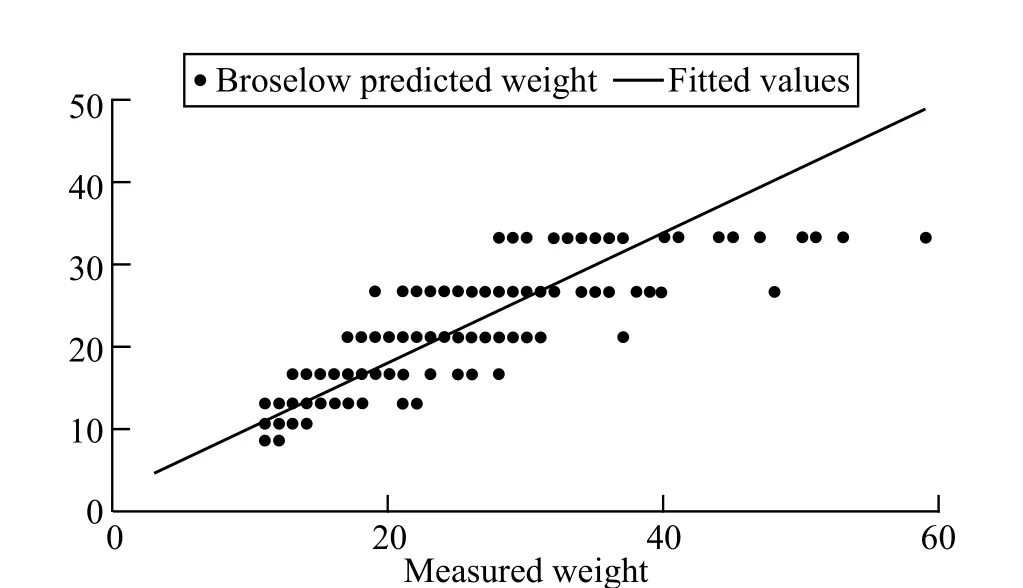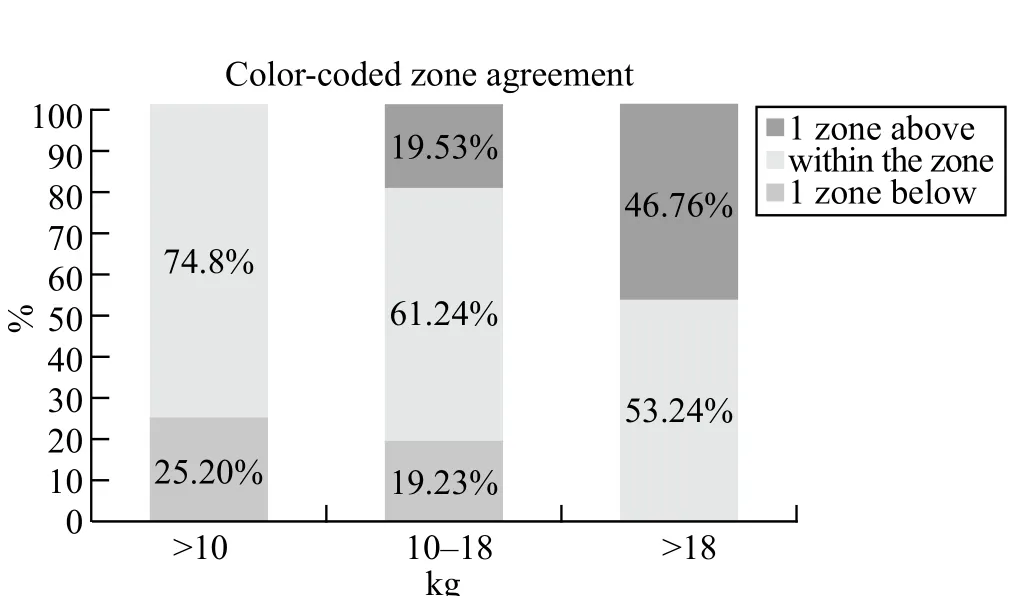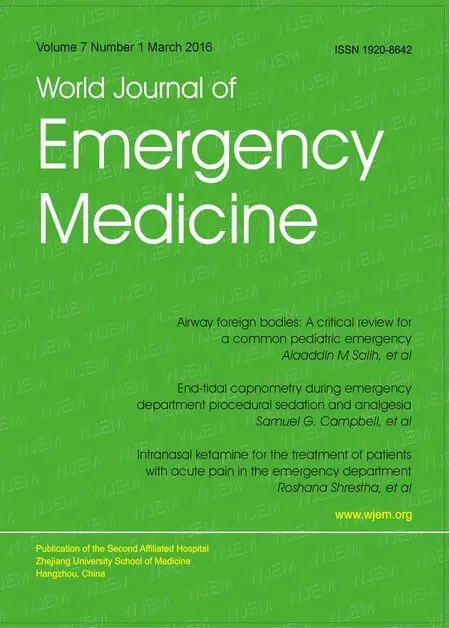A correlation analysis of Broselow™ Pediatric Emergency Tape-determined pediatric weight with actual pediatric weight in India
Deepak Geetaprasad Mishra, Tamorish Kole, Rahul Nagpal, Jeffery Paul SmithDepartment of Emergency Medicine, Max Health Care, New Delhi 007, IndiaDepartment of Pediatrics, Max Health Care, New Delhi 007, IndiaDirector of International Program, Ronald Reagan Institute of Emergency Medicine, GWU, USA
A correlation analysis of Broselow™ Pediatric Emergency Tape-determined pediatric weight with actual pediatric weight in India
Deepak Geetaprasad Mishra1, Tamorish Kole1, Rahul Nagpal2, Jeffery Paul Smith31Department of Emergency Medicine, Max Health Care, New Delhi 110017, India
2Department of Pediatrics, Max Health Care, New Delhi 110017, India
3Director of International Program, Ronald Reagan Institute of Emergency Medicine, GWU, USA
KEY WORDS:Body weights and measures; India; Child; Emergencies; Developing countries
World J Emerg Med 2016;7(1):40–43
INTRODUCTION
Pediatric resuscitation has always been a great challenge for the emergency physician because parameters such as drug doses, defibrillator energy settings, and equipment sizes are determined by body weight.The effectiveness of emergency interventions will ultimately depend on an accurate estimation of pediatric weight.Therefore, an accurate estimate of pediatric body weight is critical for the optimal management of pediatric emergencies.
Historically, pediatric weight has been estimated visually,[1–2]although calculating the weight from the age and height of a child has proven ineffective in reducing errors[3–6]and has resulted in improper dosing.[7–11]In aprevious study of medical errors in a hospital from the United States, the pediatric service was found to be the most error-ridden, with flawed dose calculations being the most common medical error in prescribing treatment.[12]Various methods have now been devised to rapidly estimate pediatric weight for use in the emergency setting, including simple and complex formulae based on age, height, or body habitus (slim, average, or heavy).
The Broselow™ Pediatric Emergency Tape has been used for over three decades in the United States, and has provided physicians with standardized pre-calculated medication doses and equipment sizes based on heightweight correlations (height range, 46–143 cm).The tape is color-coded, simple-to-use, and its use has been widely adopted.The effectiveness of the Broselow™ Pediatric Emergency Tape has been studied with mixed results in Switzerland,[13]Australia,[14]South Korea,[15]and other countries.Compared with visualization estimates, however, the use of a height-based system has proved to be more successful in reducing medical errors.[16]
The present study hypothesized that the Broselow™Pediatric Emergency Tape would overestimate weights in Indian children aged<10 years, leading to inaccurate medication dosing and equipment sizing.
METHODS
Study design
The present study prospectively enrolled patients aged <10 years who attended the outpatient department for regular check-ups and minor complaints.This study was carried out during October 2012–December 2012.Patients with medical conditions that might substantially affect body weight or height or those >10 years old were excluded.We used the Broselow Pediatric Emergency Tape, 2007, Edition B, Armstrong, Medical Industries, IL, USA.To determine the degree to which the Broselow Pediatric Emergency Tape determined weight could predict actual weight in children under 143 cm (tape limit), patients were subdivided into three categories: <10 kg, 10–18 kg, and >18 kg.The primary investigator measured the Broselow weight in all patients according to the Pediatric American life support (PALS) guidelines.Briefly, the child laid in the supine position and height was measured using the tape placed from the head to the heel.The actual weight was recorded using a child or baby scale, which was recalibrated daily, with all heavy clothes and shoes removed before measurement.
Informed consent for the use of patient data and enrollment in the study was provided by patients' guardians.The study design was approved by the Institutional Review Board (CTRI/2012/08/002918, Registered on: 27/08/2012).
Statistical analyses
Descriptive methods were used to summarize the data from this study using the commercial software STATA system version 9.0.Bland-Altman analysis[17]was performed.The percentage difference was observed between the Broselow-predicted weight and the measured weight as a measure of tape bias (100* [measured weight]) Broselow-predicted weight measured weight.The null hypothesis stated the Broselow-predicted weight was equivalent to the measured weight if the 95% confi dence interval (CI) for the mean percentage difference was ±3%.The SD of percentage difference was also calculated to estimate tape precision.
RESULTS
The patient cohort varied widely in age (range 1–156 months) and body weight (range 2.7–46 kg).No patient fall in less the 3 kg weight and 46.76% of patients fall above 36 kg ( Figure 1).The characteristics of the 603 children are presented in Table 1.

Figure 1.Regression analysis of measured weight versus Broselow™Pediatric Emergency Tape-predicted weight for 603 Indian children.

Table 1.Patient characteristics
The mean percentage agreement between the Broselow™-predicted weights and measured weights is summarized in Table 2.The mean percentage difference was signifi cantly greater in the 10–18 kg (1.8%) and the>18 kg (9.3%) groups than in the <10 kg (0.88%) group.
The limits of agreement for Bland-Altman analysis suggested that the tape was most concordant in the <10 kg weight group (0.14–0.07, ±0.22 kg) and 10–18 kg group (0.15–0.08, ±0.23 kg) compared with the >18 kg group (–0.51– –0.92, ±0.11 kg) (Figure 2).
The accuracy of color-coded zone prediction and weight prediction are shown in Table 2.The total agreement for color-coding across all patients was 63.18% (Table 2).
The Broselow™ color-coded zone agreement was 74.8% in the <10 kg group, 61.24% in the 10–18 kg group, and 53.42% in the >18 kg group (Figure 2).The overall agreement analysis between the actual weight and the Broselow™ tape color-coded zone weight of the three groups are shown in Figure 1.

Table 2.Total agreement between Broselow™ color-coding and actual weight in all patients, n (%)

Figure 2.Color-coded zone agreement for each weight group.
DISCUSSION
For pediatric resuscitation, accurate weight estimation is of vital importance, but it is difficult physically to weigh a patient in an emergency.The Indian Academy of Pediatrics[18]recommends that PALS guidelines are followed for resuscitation, and the PALS guidelines recommend the use of the Broselow™ Pediatric Emergency Tape.
The World Health Organization's 2006 growth standards suggest that genetic influences on childhood weight for length are minimal, and that breastfed children in healthy global communities can be expected to achieve similar heights and weights for a given age.[19]This assumption implies that the same anthropometric methods used to predict children's weights in the United States, such as the Broselow™ Pediatric Emergency Tape, would be useful in similar international settings.Confi rming these guidelines, previous studies in the United States, Europe, and other developed countries have found no significant variation in weight prediction by race or ethnicity.[17]However, when the Broselow™ Pediatric Emergency Tape is used in Indian children, weight overestimation has been noted as a reason for serious concern.[20]
Overestimation of equipment size by the Broselow™Pediatric Emergency Tape may lead to serious injury or potentially life-threatening time delays during procedures.Recent researches into the accuracy of the Broselow™Pediatric Emergency Tape conducted in the United States have raised concerns regarding underestimations of drug dosages secondary to the obesity epidemic in children.
The use of Broselow™ Pediatric Emergency Tape in Indian children was compared with that reported in a recent validation study performed in North American children.[21,22]The results indicated that the tape is signifi cantly less accurate in the Indian childdren.In the US study, the accuracy of the tape was assessed in North American children categorized into age and weightbased groups [<12 months old (<10 kg); 12–59.9 months old (10–18 kg); and >60 months old (>18 kg)].Although the age and weight categories could not be compared precisely, the age and weight ranges in the present data set are similar.The Broselow™ Pediatric Emergency Tape for Indian children compares favorably with that for American children in the <10 kg group and 10–18 kg group, but it is significantly less accurate for Indian children weighing >18 kg.
In the present study, we tried to give more evidence supporting that the tape will perform better in higher socio-economic countries.In private hospital, category 2 was validated without correction factor and only category 3 required further validation.[17]
This study aimed to address the internationalization and validation of the Broselow™ Pediatric Emergency Tape in developing countries such as India.However, the study has some limitations.The study was conductedby a single investigator at a single hospital.In addition, although the hospital is a large quaternary referral center that attracts a wide range of urban and rural middle class patients from all over Northern India.Hence, the data from those with a lower socioeconomic status were not included, introducing an element of patient selection bias.
In conclusion, the implementation of the BroselowTM Pediatric Emergency Tape in India to estimate pediatric weight accurately in the emergency setting will reduce medical errors.The tape is more reliable in children of the <10 kg and 10 to 18 kg groups.However, as pediatric weight is increased, predictive reliability is also decreased, especially in those weighing>18 kg.Thus, an alternative method of weight estimation may be needed in Indian children although the tape is likely to reduce medical errors compared with visual estimation of weight.
Funding: None.
Ethical approval: The study design was approved by the Institutional Review Board (CTRI/2012/08/002918, Registered on: 27/08/2012).
Confl icts of interest: The authors have no competing interests to declare.
Contributors: Mishra DG proposed the study, analyzed the data and wrote the fi rst draft.All authors contributed to the design and interpretation of the study and to further drafts.
REFERENCES
1 Anglemyer BL, Hernandez C, Brice JH, Zou B.The accuracy of visual estimation of body weight in the ED.Am J Emerg Med 2004; 22: 526–529.
2 Harris M, Patterson J, Morse J.Doctors, nurses, and parents are equally poor at estimating pediatric weights.Pediatr Emerg Care 1999; 15: 17–18.
3 Broselow J, Luten R, inventors; Vital Signs, Inc, assignee.Broselow pediatric emergency tape.US patents 4 713 888, December 22, 1987; 4 823 469, April 25, 1989; and 5 010 656, April 30, 1991.
4 Potts MJ, Phelan KW.Deficiencies in calculation and applied mathematics skills in pediatrics among primary care interns.Arch Pediatr Adolesc Med 1996; 150: 748–752.
5 Rowe C, Koren T, Koren G.Errors by paediatric residents in calculating drug doses.Arch Dis Child 1998; 79: 56–58.
6 Lesar TS.Errors in the use of medication dosage equations.Arch Pediatr Adolesc Med 1998; 152: 340–344.
7 Koren G, Barzilay Z, Greenwald M.Tenfold errors in administration of drug doses: a neglected iatrogenic disease in pediatrics.Pediatrics 1986; 77: 848–849.
8 Thomas EJ, Studdert DM, Burstin HR, Orav EJ, Zeena T, Williams EJ, et al.Incidence and types of adverse events and negligent care in Utah and Colorado.Med Care 2000; 38: 261–271.
9 Leape LL, Brennan TA, Laird N, Lawthers AG, Localio AR, Barnes BA, et al.The nature of adverse events in hospitalized patients.Results of the Harvard Medical Practice Study II.N Engl J Med 1991; 324: 377–384.
10 Bates DW, Cullen DJ, Laird N, Petersen LA, Small SD, Servi D, et al.Incidence of adverse drug events and potential adverse drug events.Implications for prevention.ADE Prevention Study Group.JAMA 1995; 274: 29–34.
11 Leape LL, Bates DW, Cullen DJ, Cooper J, Demonaco HJ, Gallivan T, et al.Systems analysis of adverse drug events.ADE Prevention Study Group.JAMA 1995; 274: 35–43.
12 Kaushal R, Bates DW, Landrigan C, McKenna KJ, Clapp MD, Federico F, et al.Medication errors and adverse drug events in pediatric inpatients.JAMA 2001; 285: 2114–2120.
13 Lesar TS, Lomaestro BM, Pohl H.Medication-prescribing errors in a teaching hospital.A 9-year experience.Arch Intern Med 1997; 157: 1569–1576.
14 Hofer CK, Ganter M, Tucci M, Klaghofer R, Zollinger A.How reliable is length-based determination of body weight and tracheal tube size in the paediatric age group? The Broselow tape reconsidered.Br J Anaesth 2002; 88: 283–285.
15 Black K, Barnett P, Wolfe R, Young S.Are methods used to estimate weight in children accurate? Emerg Med (Fremantle) 2002; 14: 160–165.
16 Jang HY, Shin SD, Kwak YH.Can the Broselow tape be used to estimate weight and endotracheal tube size in Korean children? Acad Emerg Med 2007; 14: 489–491.
17 Ramarajan N, Krishnamoorthi R, Strehlow M, Quinn J, Mahadevan SV.Internationalizing the Broselow tape: how reliable is weight estimation in Indian children.Acad Emerg Med 2008; 15: 431–436.
18 Shah AN, Frush K, Luo X, Wears RL.Effect of an intervention standardization system on pediatric dosing and equipment size determination: a crossover trial involving simulated resuscitation events.Arch Pediatr Adolesc Med 2003; 157: 229–236.
19 Lubitz DS, Seidel JS, Chameides L, Luten RC, Zaritsky AL, Campbell FW.A rapid method for estimating weight and resuscitation drug dosages from length in the pediatric age group.Ann Emerg Med 1988; 17: 576–581.
20 Gragnolati M, Shekar M, Das Gupta M, Bredenkamp C, Lee Y-K.India's undernourished children.A call for reform and action.Health, Nutrition and Population (HNP) Discussion Paper.The World Bank.2005 Aug.
21 Bhandari N, Bahl R, Taneja S, de Onis M, Bhan MK.Growth performance of affluent Indian children is similar to that in developed countries.Bull World Health Organ 2002; 80: 189–195.
22 Varghese A, Vasudevan VK, Lewin S, Indumathi CK, Dinakar C, Rao SD.Do the length-based (Broselow) Tape, APLS, Argall and Nelson's formulae accurately estimate weight of Indian children? Indian Pediatr 2006; 43: 889–894.
Received July 25, 2015
Accepted after revision December 28, 2015
BACKGROUND: The Broselow™ Pediatric Emergency Tape indicates standardized, precalculated medication doses, dose delivery volumes, and equipment sizes using color-coded zones based on height-weight correlations.The present study attempted to provide more evidence on the effectiveness of the Broselow™ Pediatric Emergency Tape by comparing the tape-estimated weights with actual weights.We hypothesized that the Broselow™ Pediatric Emergency Tape would overestimate weights in Indian children aged<10 years, leading to inaccurate dosing and equipment sizing in the emergency setting.
METHODS: This prospective study of pediatric patients aged <10 years who were divided into three groups based on actual body weight: <10 kg, 10–18 kg, and >18 kg.We calculated the percentage difference between the Broselow-predicted weight and the measured weight as a measure of tape bias.Concordant results were those with a mean percent difference within 3%.Standard deviation was measured to determine precision.Accuracy was determined as color-coded zone prediction and measured weight concordance, including the percentage overestimation by 1–2 zones.
RESULTS: The male-to-female ratio of the patients was 1.3:1.Total agreement between colorcoding was 63.18% (κ=0.582).The Broselow™ color-coded zone agreement was 74.8% in the <10 kg group, 61.24% in the 10–18 kg group, and 53.42% in the >18 kg group.
CONCLUSIONS: The Broselow™ Pediatric Emergency Tape showed good evidence for being more reliable in children of the <10 kg and 10–18 kg groups.However, as pediatric weight increased, predictive reliability decreased.This raises concerns over the use of the Broselow™ Pediatric Emergency Tape in Indian children because body weight was overestimated in those weighing >18 kg.
Corresponding Author:Deepak Geetaprasad Mishra, Email:dr.deepak@hotmail.com.
DOI:10.5847/wjem.j.1920–8642.2016.01.007
 World journal of emergency medicine2016年1期
World journal of emergency medicine2016年1期
- World journal of emergency medicine的其它文章
- Airway foreign bodies: A critical review for a common pediatric emergency
- End-tidal capnometry during emergency department procedural sedation and analgesia: a randomized, controlled study
- Intranasal ketamine for the treatment of patients with acute pain in the emergency department
- Analgesic effect of paracetamol combined with lowdose morphine versus morphine alone on patients with biliary colic: a double blind, randomized controlled trial
- Comparison of intravenous pantoprazole and ranitidine in patients with dyspepsia presented to the emergency department: a randomized, double blind, controlled trial
- Emergency department patients with small bowel obstruction: What is the anticipated clinical course?
